Susan Taylor-Leduc
In 2014, on the occasion of the bicentenary of Joséphine Bonaparte’s death, an exhibition at the Musée du Luxembourg summarized her compelling life story:
She was not born a princess, nor even with the name of Joséphine, and still less was she destined to reign one day, but it is possible that she dreamed, in her childhood, of becoming more than a queen, as a fortune-teller once predicted. Yet this fabulous destiny owed nothing to chance. Her aristocratic and Caribbean origins (she belonged, in fact, to a noble family, the Tascher de la Pagerie family, which had its roots in Martinique) placed her in the caste of the great sugar planters. Like all Créoles, she felt first and foremost American and throughout her life she maintained a visceral attachment to her country, its customs (freer than in France) and its luxuriant nature. It is perhaps Joséphine’s Créole identity that explains the taste for luxury and pomp displayed by all the women around her, from mistress to slave. It was certainly also the source of her passion for flowers and exotic birds.[1]
The author claims that the climate of the Caribbean influenced Joséphine’s habits and collections, conjuring a personification of her as an exotic Other.[2] Questioning this beguiling reading, in this essay I argue instead that deconstructing Joséphine’s white Créole heritage reveals another narrative, one where she strategically used her Créole identity to assert her agency.[3] Turning to her patronage at Malmaison, a landscape garden she cultivated from 1799 until her death in 1814, I argue that Joséphine deployed a “politics of acclimatization”—transferring, grafting, and hybridizing flowers, trees, and shrubs from around the world—as a metaphor for her own transplantation from the colonies to the metropole.[4] From her acculturated realm, Joséphine fashioned herself as a benevolent savant, devoted consort, and amateur botanist, performances that were uniquely possible when we consider her garden as an organic self-portrait.[5]
Joséphine’s identity was particularly tied to her marital status: twice married and divorced, mother, wife and grandmother, Joséphine’s “selves” were inextricably bound to her rank.[6] Although it is not possible to rehearse the complexities of Joséphine’s dependency on Napoleon’s directives here, we can establish that Napoleon consistently sustained Joséphine’s lavish investments in her garden throughout her lifetime.[7] She negotiated the purchase of Malmaison when General Bonaparte was in Egypt, a fait accompli that he ultimately underwrote.[8] As Emperor, he financed the expansion of the property from a 64-hectare garden to a 700-hectare estate. At the moment of the divorce, despite the recently enacted civil codes that severely restricted female property ownership, Napoleon gifted Malmaison to Joséphine as part of her divorce settlement.[9]
As consort, Joséphine reigned at the center of an Imperial court where she was expected to emulate ancien régime queens who endorsed garden patronage as signifiers of fertility to legitimize their roles as procreating mothers of future rulers.[10] Joséphine certainly hoped that by “seeding the nation” her garden would continue this iconological trope and deflect anxieties about her own fecundity; inevitably, her gardens could not assume this semiotic charge.[11] As a heterotopic space, Malmaison continued to signify fertility, and as such, Joséphine’s politics of acclimatization enabled her to shift the iconography from a cipher of personal fertility to a post-revolutionary conception of regenerative nature. Malmaison became a hybridized space where the taxonomies that separated nature into binary spheres, indigenous and exotic, male and female, were deliberately mixed, offering a range of possibilities for self-fashioning.[12] From this perspective, Joséphine’s adoption of acclimatization was a savvy intellectual and political move that allowed her to negotiate self and other in her garden.[13]
At the end of the eighteenth century, notions about climate and the contingent field of acclimatization were inchoate disciplines: combining botany, geography, and philosophy, enlightenment scholars speculated about how human beings, animals, and plants could adapt (or degenerate) when forcibly displaced from their local habitats.[14] While savants, naturalists, and botanists at the Jardin des Plantes and Musée d’histoire naturelle spearheaded scientific debates, Joséphine’s response to this discourse was not only intellectual but material: she would defend her Créole identity and defy claims of degeneracy in her greenhouses and conservatories.[15]
Debates about climate theory were not limited to the scientific community, but became a political tool to justify France’s imperial control over its colonies.[16] Napoleon launched ambitious plans to reclaim control of the sugar islands, invoking the climate as a means to justify new laws applying to these territories:
This provision (aka the creation of special laws for the colonies) derives from the fact that nature and climate are different in these locations. The inhabitants of the French colonies situated in America, in Asia, in Africa cannot be governed by the same law. The difference of habits, customs, interests, the diversity of the soil, cultures, productions require various modifications….[17]
As scholars of the French Atlantic Empire recognize, this declaration was a prelude to the re-institution of slavery in 1802.[18] As Thierry Lentz has indicated, Napoleon did not depend on Joséphine’s advice to inform his policies about the slave trade; however, Joséphine aligned her patronage in order to support Imperial initiatives.[19]
W. J. T. Mitchell reminds us that “Imperialism is not a one-way phenomenon” but “a complicated process of exchange, mutual transformation and ambivalence” that was particularly suited to landscape gardening.[20] Mitchell also points out that the aestheticization of imperial politics deliberately obfuscated the violent processes of “expropriation, collaboration, and coercion” of colonization. While exploring the tensions between climate theory, imperial politics, and colonial policy is beyond the scope of this paper, Joséphine’s engagement with acclimatization was not that of an outsider: rather, her activities endorsed the colonial machine and militaristic means that drove Napoleonic expansion.
Considering Joséphine’s garden patronage as a manifestation and aestheticization of imperial policy suggests that Joséphine’s patronage was not solely a question of exercising her taste, but a concerted effort to create a self-portrait that could be adapted to changing political circumstances in order to secure her status at court. The first section of this article revisits how Joséphine used her Créole heritage to celebrate her blanchitude at Malmaison and in so doing aligned herself with the colonial machine. The second section focuses on how Joséphine’s identity as Consulesse promoted Malmaison as a model for property owners looking to assimilate to the new power structures of the Consular period.[21] The third section focuses on how Joséphine, as Empress, exploited her considerable financial and political clout from 1804 until 1809 to help expand Imperial ambitions in the Pacific arena. Joséphine’s claim to the botanical booty from Nicolas Baudin’s expedition to Australia in 1800-1803 perhaps signaled her desire to assert herself on the international stage, symbolically competing with Queen Charlotte’s patronage at Kew.[22] The final section looks at how Joséphine represented herself in her retirement at Malmaison from 1809 until her death.[23] Joséphine commissioned the esteemed botanical illustrator Pierre-Joseph Redouté (1759–1840) to document the blooms that flourished under her care, ensuring that her garden would survive, especially after her body, and indeed herself, was repudiated by the emperor and cast aside by the nation.[24]
From Martinique to Malmaison: Mobilizing Sugar
When Rose Marie Joséphine Tascher de la Pagerie (1763-1814) lived in Martinique from 1763 to 1779 (she returned briefly in 1788-1790 and precipitously fled civil unrest), the island had a population of approximately 85,000 slaves, 11,000 whites, and 5,000 free people of color.[25] From her birth on the family plantation and throughout her youth, Joséphine circulated in a mixed-race society where her family’s origins determined her class. During the ancien régime, the adjective “Créole” reflected complex social and linguistic constructions that included glorifying whiteness, which was not necessarily a question of skin color but of social status. It is precisely Joséphine’s whiteness, her blanchitude, that allows us to focus more specifically on how she negotiated her place in the French colonial empire.[26]
Joséphine’s paternal grandfather, Gaspar-Joseph Tascher de La Pagerie (1705–1767), descended from a noble lineage and emigrated to the island in 1726. His son assumed management of the family plantation in 1761 upon his marriage to Rose-Claire des Vergers de Sannois (1736–1807), whose family had been established planters for generations. Joséphine’s immediate family was most closely associated with les petit blancs, those whose fortunes hinged upon the production of sugar. But after she married Alexandre de Beauharnais (1760–1794), whose family served as ruling governors at the apogee of the French social-judicial system on Martinique, she became associated with les grands blancs. They represented the powerful sugar lobby of planters who defended slavery in order to maintain their properties and financial investments before, during, and after the French Revolution.[27]
Joséphine’s close familiarity with the slave economy is indisputable. Not only was her home located at the center of the La Pagerie plantation (originally known as La Petite Guinée because of the large number of African slaves), where she would have witnessed the grueling labor of sugar production, but she would also have known about the refining of crystals from the sugar cane plant that enabled the La Pagerie family to sell as much as 700,000 pounds of sugar a year from their plantation.[28] Joséphine parlayed her lived experience of the plantation into an insider’s knowledge of the international sugar trade: she speculated on revenue from her family’s sugar production as a means to ensure her financial credit.[29]
Joséphine’s ability to obfuscate her own, and her family’s debt, became a modus operandi throughout her lifetime. When Joséphine fixated on acquiring Malmaison she would have appreciated that the owner, Jean-Jacques Le Couteulx du Molay (1740–1823), was also familiar with the sugar trade as he had worked with her close friend Thérèse Cabarrus’s father in several banks and trading outposts in Madrid, Paris, and Martinique.[30] Purchasing Malmaison, Joséphine thus asserted her place on both sides of the Atlantic, announcing that she would continue the tradition of former noble financiers who had gardens in the metropole and plantations in the colonies. She enhanced her family’s status on Martinique and assured her Créole client networks that the sugar economy would continue to thrive under Napoleonic policies. Joséphine’s politics of acclimatization included the planting of sugar cane at Malmaison, asserting her Créole heritage of blanchitude in order to continue to thrive in the metropole.[31]
Malmaison: Naturalizing the Exotic
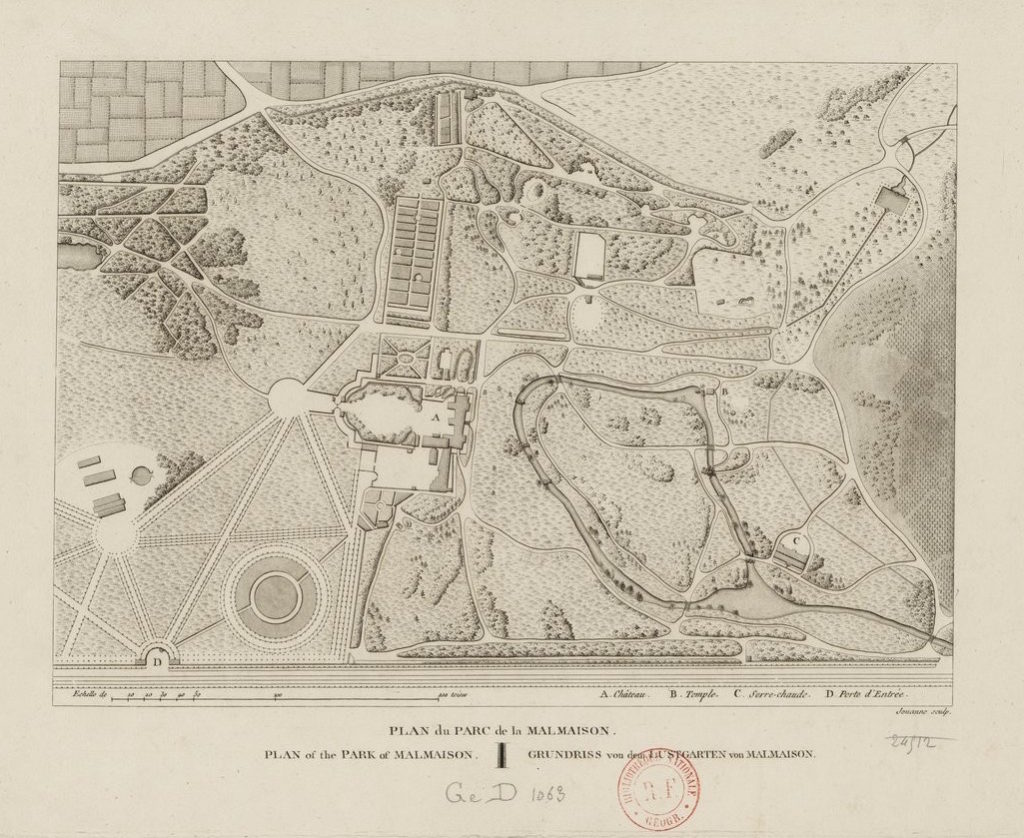
Once Joséphine secured the purchase of Malmaison, she immediately set out to redesign the garden. She hired four landscape garden designers in five years, until Louis-Martin Berthault (1770–1823) finally devised a plan that suited her vision. Berthault expanded upon the garden’s existing picturesque motifs. As we can see in a plan from around 1812 (Fig. 1), the garden was organized as a series of interlocking, serpentine paths, a winding river that led to an artificial pond where one could take boat rides, and clumps of trees and shrubbery strategically placed to frame views across the lawns. The clear indication of the greenhouse (C) on the plan signals its significance for the garden program. Auguste Garneray’s set of twelve watercolors of Malmaison (c. 1812) evoke the garden in its maturity.[32] The View of the Garden from the Château (Fig. 2) and the View from the Garden from the Stone Bridge Looking to the Château (Fig. 3) show flourishing trees of different varieties, textures, and colors that frame verdant green lawns.[33] In the view from the château, Garneray gives the illusion that the property extends to the aqueduct of Marly, barely distinguishable on the horizon. In the view from the garden, the extensive lawn is again depicted as a broad expanse leading the eye to the house nestled in the background.
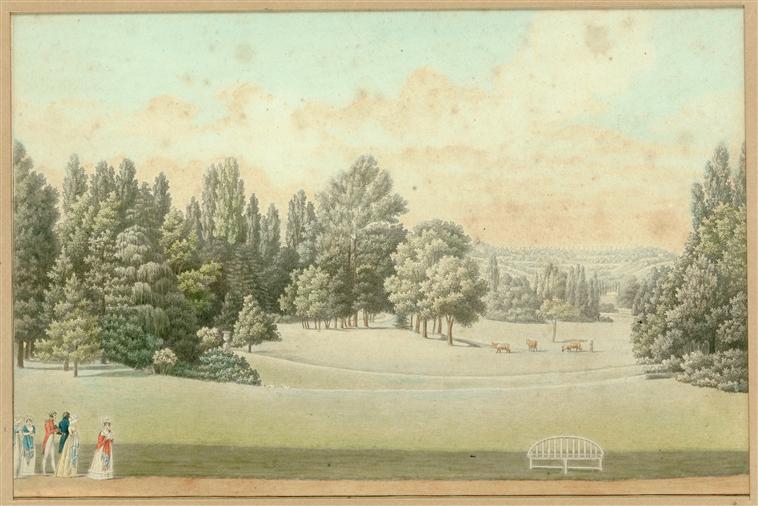
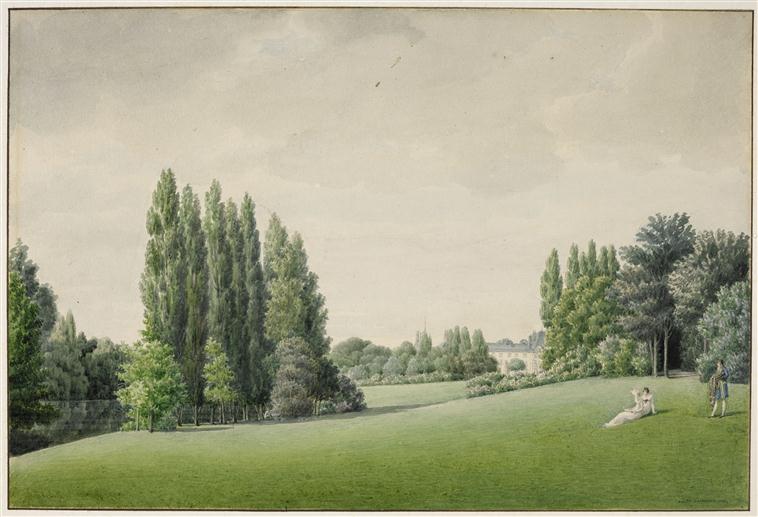
How can we determine any influence of Joséphine’s Créole identity in this seemingly immutable vision of the landscape? Certainly, as Jill H. Casid has argued, the extensive labor necessary to make a picturesque garden—extensive clearing, canalization, and replanting—replicated the same techniques that were necessary for the creation of sugar plantations on Martinique.[34] Joséphine clearly understood that the picturesque style could re-signify colonization by highlighting the fact that her lush garden was a hybrid space, like a sugar plantation: both spaces were visibly distinct from the surrounding indigenous landscape. At Malmaison, the number and variety of trees were arranged to enhance the views, but they also revealed Joséphine’s ostentatious investments in the colonial machine that made her acculturated landscape possible.
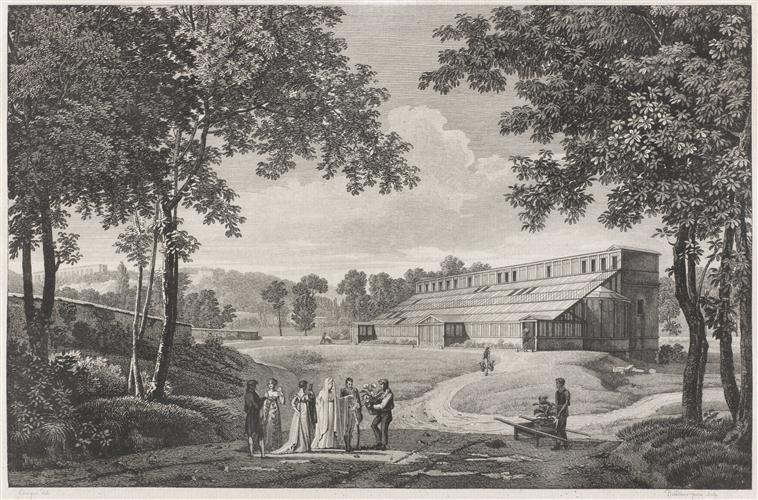
One of the major attractions of the garden was its greenhouse. In a View of the Greenhouse (Serre chaude) after Constant Bourgeois (Fig. 4), the engraver emphasizes the building’s exceptional size (50 meters long) and innovative glass construction, its transparent panes permeating the light so necessary for Joséphine’s acclimatization. Furthermore, the image indicates how the greenhouse was integrated into the garden stroll, with Joséphine escorting guests to visit it and being intercepted by a gardener presenting her with flowers. Joséphine also built an aviary and a menagerie, as well as a farm for merino sheep, all spaces where she announced her intentions to bring plants and animals from around the world to her garden. Glimpsing some of the plants on display in a View of the Interior of the Green House (Fig. 5), we can almost feel the heat and humidity necessary for these species to flourish, the luxuriant nature barely contained by the iron and glass structures. Joséphine installed twelve carbon stoves to heat her greenhouse year-round.
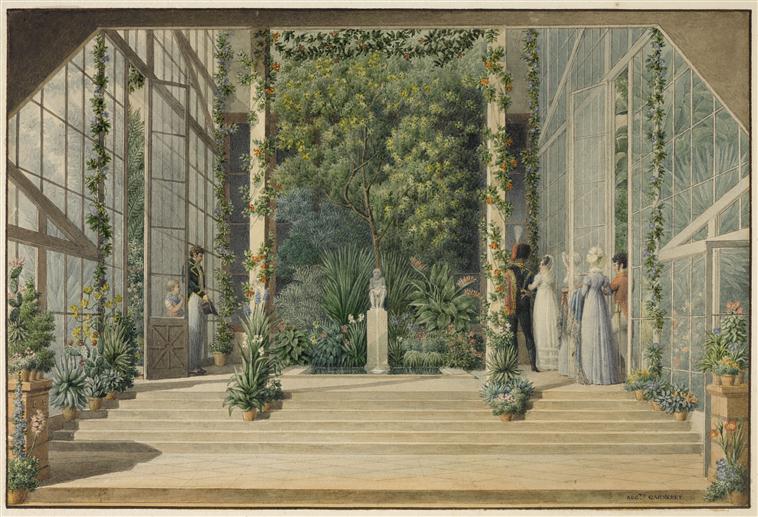
Certainly, Joséphine’s patronage echoed the popularity of botanical collecting at the time, yet her garden became a place to display not only her blooms but also her ability to acclimate new species.[35] By March 1804, 2,014 plants, trees, and shrubs were delivered to Malmaison, and, as the inventory after Joséphine’s death reveals, the number of plants increased to the thousands during her reign.[36] Although many of her plants could survive only in the greenhouses, the majority were displayed in pots or boxes. During this period several species were introduced to France for the first time, such as eucalyptus, hibiscus, phlox, catalpa, camellia, myrtles, geraniums, cacti, rhododendrons, certain dahlias, and magnolias.
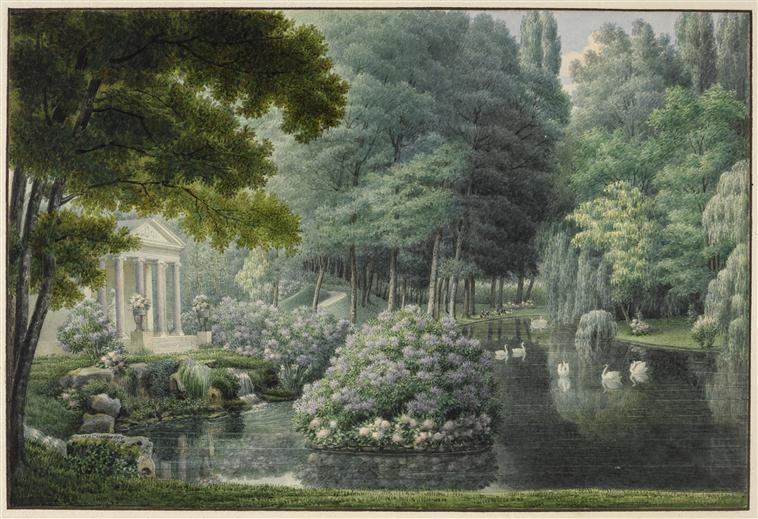
In Garneray’s View of the Temple of Love (Fig. 6), the stunning display of rhododendrons, acclimated for the first time in France at Malmaison, implies how Joséphine highlighted the colorful shrubberies that were acclimated under her care while integrating them into the picturesque design that included both indigenous forest species and trees already acclimated to France from North America. The Doric Revival temple was a well-established trope, perhaps meant to underscore Josephine’s devotion to her husband, but here the flowers and trees are seemingly as important as the Temple of Love, suggesting how Joséphine re-generated the nation. This picturesquely idyllic spot, visible when strolling or on a boat ride, erased any references to the colonial appropriation necessary for obtaining these species.
Joséphine’s politics of acclimatization were not, however, limited to importing trees and shrubberies from the Atlantic world; she equally exploited her garden as a place to celebrate her husband’s military conquests. When Napoleon returned victorious from the battle of Marengo in July 1800, Joséphine welcomed him to Malmaison and promptly planted a cedar tree from Lebanon, which still flourishes in situ today, to commemorate the triumph. Joséphine sublimated the military reversals of the Egyptian campaign by planting a species from the Orient that nonetheless sanctioned Napoleon’s military missions.
Three years later, Joséphine’s chief botanist, Étienne Pierre Ventenat (1757–1808), who was charged with documenting her collections, clearly linked her passion for plants and flowers to Napoleonic campaigns:
You have gathered around you the rarest plants growing on French soil. Some indeed, which never before left the deserts of Arabia or the burning sands of Egypt, have been domesticated through your care. Now, regularly classified, they offer to us, as we inspect them in beautiful gardens of Malmaison, an impressive reminder of the conquests of your illustrious consort…[37]
Ventenat not only documented known plants in his two-volume luxury edition, but he also named species after Joséphine, such as the Josephina couronnée, a white flower sent from the Cape of Good Hope, which he first raised in the hothouses and then planted in her gardens. Naming plants both flattered Joséphine’s patronage and connected her to an international community of savants, equating her botanical collecting with that of gentlemen amateurs whose collections were dedicated to the dissemination of knowledge.
From this perspective, to consider Joséphine’s politics of acclimatization as “nostalgia” for her native Martinique diminishes her self-fashioning as a privileged purveyor of Consular and Imperial polities to support her position at court. She transformed Malmaison into a venue that symbolically materialized and legitimized Napoleonic directives.[38] From 1799 until 1804, Napoleon reversed Revolutionary laws in order to re-institute slavery and allow émigrés to return to France.[39] During the Consulate, property owners, including colonial planters, returning émigrés, and those who had acquired property during the Revolution could look to Malmaison as a model for their own gardens. Joséphine’s politics of acclimatization effectively suppressed the iniquity of the colonial machine but also signaled how Consular decrees would take precedence over Revolutionary laws.
Imperial Ambitions: Les Îles Joséphine 1804–1809
Joséphine established a vast network of correspondence with planters and nurserymen to supply her garden. Her estate managers, Charles-François Brisseau de Mirbel (1776–1854) and Aimé-Jacques-Alexandre Goujaud, called Bonpland (1773–1858), were eminent naturalists and botanists who had close relations with the Musée d’histoire naturelle and brokered the networking between the Jardin des Plantes and commercial endeavors.[40] Joséphine certainly would have known of Nicolas Baudin (1754–1803), who sailed to the Caribbean between 1796 and 1798 to bring plants from Trinidad to the Musée d’histoire naturelle.[41] In March 1800, Baudin presented a plan to the First Consul to sail to New Holland (mainland Australia) and Van Dieman’s Land (Tasmania). Napoleon, a member of the Institut de France since 1792, supported Baudin’s expedition as a means of rivaling the British, enhancing his own position as an enlightened leader, and promulgating the continuity of French exploration after the loss of the exploratory voyage of the La Pérouse (1793). However, it was Joséphine who ultimately reaped the botanical rewards from this journey.
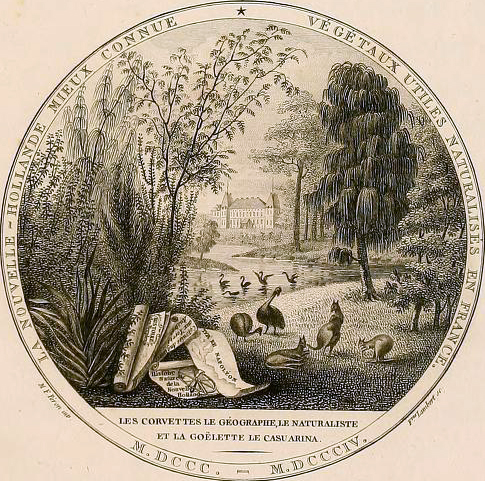
Baudin’s expedition brought thousands of species to France.[42] The then Interior Minister, Jean-Antoine Chaptal (1756–1832), explicitly stated that the museum professors who sponsored the trip were expected to give priority to Madame Bonaparte’s requests for animals and plants.[43] Joséphine guaranteed that she would be able to claim credit for Baudin’s voyage by underwriting the subscription to the first volume of the Voyage de Découverte aux Terres Australes by François Péron, completed in 1807 (a second edition with illustrations and an atlas was published in 1816).[44] The frontispiece showcased Malmaison, thereby linking the garden to the voyage (Fig. 7). The inscription reads: La Nouvelle Hollande, Better Known, Useful Plants, 1800–1804. The reference to the two boats, the Géographe and the Naturaliste, are inscribed on the lower register. Within the oval frame, Malmaison is depicted in the background and the picturesque lawns in the foreground have been planted with specimens from Australia: on the left, we can see rather accurate depictions of mimosa Acacia, myrtles, and a Phormium plant known as the “linen from Nouvelle Zelande.” A parchment on the lower left alludes to the lingering controversy about this voyage: it is inscribed Terre Napoleon.
In fact, Napoleon and Joséphine hoped that after Baudin’s voyage the territories known as New Holland would be named for them, signaling their personal investment in Imperial conquest.[45] Although France’s claims to name Australia were ultimately rejected, Péron named entire islands, peninsulas, and waterways for Joséphine and her children, suggesting that her family continued to have a stake in the Imperial throne which was clearly inscribed on the maps that documented the voyage.[46] The projection of her influence to a foreign territory further reflects how Joséphine considered both metropolitan and overseas spaces—the gardens of Malmaison, the islands of the Pacific—as venues where she could promote her own status and connect herself to the nation.
In a letter dated March 19, 1804, Joséphine admitted that her collecting inspired a “bonheur inexprimable” (inexpressible joy), but that her true ambition was for Malmaison to become a model for the nation: She wrote:
To this end, I am cultivating an innumerable quantity of trees and shrubs from the Pacific (Cape of Good Hope) and North America. I intend that, in ten years, each department will possess a collection of precious plants that were raised in my nurseries. It is especially in southern France that I think my plants will be best suited, as this soil will best recall their own land (soil) and we can import even more species from the Pacific.[47]
Mirbel, writing to the Prefect of the Alpes-Maritime region, revealed Joséphine’s capacity to trade her collections, highlighting her understanding of plants as coveted commodities:
She has the desire to multiply in her gardens at Malmaison plants that are likely to naturalize in France, and her goal is to spread these plants to the soil of the Republic […] In this case, she proposes to send several trees and shrubs from New Holland…[48]
Joséphine’s insistent claims to plants and animals from the Pacific (including her signature black swans) imply that she was acting as a trader, parlaying knowledge of plant trading from the Caribbean to the Pacific. Acquiring plants from the Baudin expedition was a unique opportunity to reassert her agency, precisely at the moment when Napoleon turned his interest away from the Caribbean and the Americas with the sale of the Louisiana Purchase in 1804.
Retirement: Immortalizing Rose
Although Joséphine’s formal education was rudimentary, she became a self-taught, highly competent amateur naturalist. The inventory of her library after her death reveals an extensive collection of natural history books. She did not practice the exacting arts of botanical illustration, where female artists such as Madeleine Françoise Basseporte (1701–1780) touted their artistic talents and scientific proficiencies, but her lavish commissions of botanical illustrations were exceptional.[49] Rather, her commissions of botanical illustrations record that her entire garden project—her politics of acclimatization—was successful. Joséphine’s luxury editions effectively ensured that her organic self-portrait would have a paper legacy.[50]
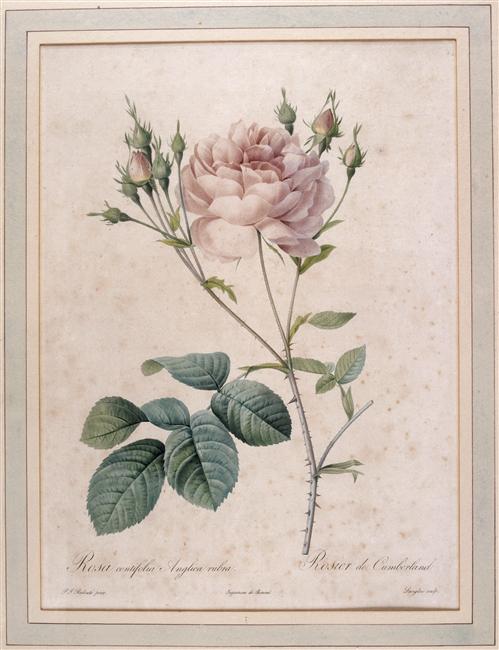
Joséphine’s decision to engage Pierre-Joseph Redouté was not surprising given his reputation as an illustrator who could capture flowers at their fullest bloom, celebrating their beauty as well as their scientific interest.[51] Ventenat first commissioned 120 engraved watercolors by Redouté for Jardins de la Malmaison (1803–1805). After Ventenat’s death, Bonpland continued this mission with the Description des plantes rare cultivées à Malmaison et Navarre (1812-1817), which included 152 plates by Redouté. In addition, Joséphine supported Redouté’s illustration of flowers: The Lilies, more than 400 plates that appeared in eight volumes from 1802-1816, and The Roses, a project published in thirty subscriptions from 1817-1824 but begun before her death. In fact, Redouté illustrated only 200 to 250 of the more than 500 roses known to have grown at Malmaison. Redouté’s Roses are perhaps his most famous works. For example, his Rosa centifolia Anglica rubra or “Rosier de Cumberland” (Fig. 8) reveals the splendor of the flower and especially the delicacy and fullness of its petals, staging the presentation for amateurs and rose enthusiasts alike.
The rose, the most feminine of flowers, did have a personal significance for Joséphine. When she met Bonaparte in 1796, he requested that she forsake her name, Rose, to become Joséphine. Joséphine reclaimed not only her name but also her mother’s—Marie-Rose—in her rose collections. Although not placed in a rose garden, her roses signaled her own complete acclimation to France and perhaps suggest how Malmaison served as her self-portrait: she was able to claim her Créole heritage, the rose of Martinique, in her gardens.
CODA: The Invisible Self-Portrait
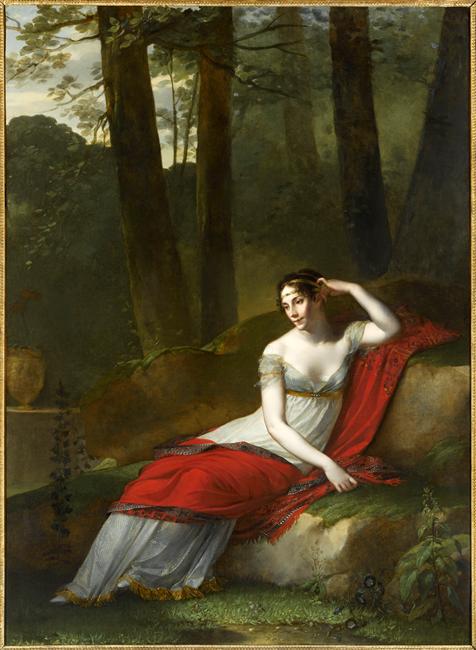
Pierre-Paul Prud’hon’s full-length portrait L’Impératrice Joséphine dans le parc de Malmaison (1805–1809) depicts Joséphine, seated on moss-covered rocks, framed by a woody glade in the background, alone in the landscape (Fig. 9).[52] The warm earth tones contrast with her skin, which is strikingly white, an effect enhanced by an almost transparent white dress that clings to her elongated form. Both her dress and her skin highlight her blanchitude.[53] The dress, despite being generously embroidered in gold, also recalls Créole costumes associated with warm climates, not the temperatures or the indigenous landscapes of France.[54] She wraps herself in a red cashmere shawl, perhaps an allusion to critiques of her dresses being inappropriate for the French climate, but equally recalling that the cashmere shawl was a gift she received from Napoleon after the Egyptian campaign.[55] Joséphine’s body is cloaked in Imperial splendor.[56]
Despite the title and the “natural” background, the actual gardens at Malmaison are notably absent from this portrait. Prud’hon has nonetheless celebrated Joséphine’s politics of acclimatization: at her feet he copied Redouté’s illustration of the Josephina couronnée, the flower from the Cape of Good Hope that Ventenat named in her honor in 1804. Prud’hon indicated other plants from her gardens, albeit in the shadows: perhaps roses in the vase to her right, perhaps myrtle from Australia. Within this monumental portrait, the plants and wildflowers at her feet seem to be a minor detail, until we shift our notions of portraiture from painting to gardening. For the gardens themselves were her self-portrait: the place where, as a white daughter of a planter from Martinique, she performed all of her identities—consort, naturalist, Créole, and mother—becoming both self and other at Malmaison thus contributing to the operations of Empire.
Susan Taylor-Leduc is a teacher, curator, and tour guide in Paris, affiliated
with the Centre de Recherche du Château de Versailles
Acknowledgements: My thanks to the anonymous readers, the editors and guest editors of this issue for their helpful comments. I would also like to thank Susan Sidlauskas, Anne Lafont, Elizabeth Hyde, Mary-Ann Moalli and Gabriela Lamy. The translations are my own.
[1] Joséphine, ed.Amaury Lefébure et al.,exhib. cat.(Paris: Musée du Luxembourg, 2014), Introduction to the catalogue, 59. For a similar interpretation, see Joséphine, La Passion des fleurs et oiseaux, ed. Amaury Lefébure and Christophe Pincemaille, exhib. cat. (Paris: Musée national des châteaux de Malmaison et Bois Préau, 2014). The most complete study to date of Joséphine’s botanical collecting remains Impératrice Joséphine et les Sciences Naturelles, ed. Christian Jouanin and Jérémie Benoit, exhib. cat. (Paris: Musée national des châteaux de Malmaison et Bois Préau, 2014), hereafter cited as Jouanin, Sciences Naturelles.
[2] Bernard Chevallier and Christophe Pincemaille, L’Impératrice Joséphine, Petit Bibliothèque Payot, 309 (Paris: Éditions Payot & Rivages, 1996), 2-29; Pierre Branda, Joséphine, Le Paradoxe du Cygne (Paris: Perrin, 2016), 17-78.
[3] Felicity Nussbaum, “Polygamy, Pamela, Empire,” in The Consumption of Culture 1600–1800, Image, Object, Text, ed. Anne Bermingham and John Brewer (London and New York: Routledge, 1995), 219. Although referring to African women, Nussbaum notes: “In spite of the century’s passion to create taxonomies of the species and maps of colonial territories, the Other can never be fully ‘known’ except in reference to the self. If Imperialism uses the Other to consolidate the Imperialist self, the Other also consolidates the European woman.”
[4] See Jouanin, Sciences Naturelles, 27. Jouanin points out the importance of acclimatization but does not suggest this process had any political ramifications, instead arguing that plant exchange was an example of Joséphine’s legendary “generosity.” Joséphine’s pursuit of acclimatization occurred in tandem at the national botanic garden: Lorelai Kurey, “Andre Thouin et la nature exotique au Jardins des plantes,” in Le jardin entre science et représentation, ed. Jean Lois Fischer (Aix-en-Provence: Editions du CTHS, 1999), 255-265. Jill H. Casid’s Sowing Empire: Landscape and Colonialization (Minneapolis: University of Minnesota Press, 2005) is a pioneering study deconstructing the colonial underpinnings of the picturesque garden in the pre-revolutionary period.
[5] This paper does not dispute that Joséphine’s gardens were filled with exotica, but instead questions how we frame “exotic” as a term to describe Joséphine. My thanks to Noémie Etienne for bringing my attention to the site www.theexotic.ch. For insightful framing of the problematic of self and other, see Susan Sidlauskas, Cezanne’s Other: The Portraits of Hortense (Berkley: University of California Press, 2009).
[6] Joséphine used the following signatures: De la Pagerie, Vicomtesse Beauharnais, Citoyenne Lapagerie, Veuve Lapagerie-Beauharnias, Madame Bonaparte, and Empress Joséphine.
[7] Bernard Chevallier, Malmaison, Château et Domain des origines à 1904 (Paris: Réunion des Musées Nationaux, 1999).
[8] Christophe Pincemaille, Il y a 200 ans, Joséphine achetait Malmaison (Rueil-Malmaison: Société des amis des Malmaison, 1999), 4-15, 36.
[9] Memoires de Mademoiselle Avrillion, Première femme de chambre de l’impératrice Joséphine, édition présentée et annotée par Maurice Dernelle (Paris: Mercure de France, 1969/1986), 299-313. Charlotte Denoël, “Le divorce de Napoléon et Joséphine,” L’Histoire par l’image (2011), http://www.histoire-image.org/fr/etudes/divorce-napoleon-josephine?i=1132 (accessed July 27, 2019).
[10] Joséphine’s determination to maintain her status as consort did not usurp gendered and institutional norms. For a comparative view of women’s opposition to Napoleon’s policies, see Waltraud Maierhofer, “Napoleon and Women? Women against Napoleon!” in Women Against Napoleon: Historical and Fictional Responses to His Rise and Legacy, ed. Waltraus Maierhofer, Gertrud Roesch, and Caroline Bland (Frankfurt: Campus, 2007), 11-31.
[11] Todd Porterfield and Susan Siegfried, Staging Empire: Napoleon, Ingres, and David (University Park: Pennsylvania State University Press, 2006), 155-169. The relationship of fertility to gardening is linguistically apparent in a letter by one of her estate managers, Charles-François Brisseau de Mirbel, who wrote: “Madame Bonaparte pense que le pays que vous habitez étant beaucoup plus chaud (Alpes-Maritimes) que le climat de Paris, il se pourrait que les plantes exotiques y donnassent de bonnes semences.” Jouanin, Sciences Naturelles, 49.
[12] Lorraine Daston, “The Naturalistic Fallacy is Modern,” Isis, 105:3 (September 2014), 579-587 reviews how appeals to nature and naturalism are politicized.
[13] Bernard Chevallier, “Empress Joséphine and the Natural Sciences,” in Of Elephants & Roses: French Natural History 1790–1830, ed. Sue Ann Prince (Philadelphia: American Philosophical Society, 2013), 35-43. Chevalier states: We do not know who introduced Joséphine to this science, so unusual for her gender” (35). Pierre Yves Lacour’s essay “Histoire Naturelle,” in 1740, Abrégé du Monde: Savoirs et Collections autour de Dezaillier d’Argenville, ed. Anne Lafont (Paris: Lafarge editions, 2012), 112-120, points out that the study of natural sciences was not only a “domaine de savoir” but equally a “science mondaine” in the eighteenth century. For a discussion on how amateur botanists and nurserymen were considered gentlemen, see Sarah Easterby Smith, Cultivating Commerce: Cultures of Botany in Britain and France, 1760–1815 (New York: Cambridge University Press, 2018), 21-39, 56-73.
[14] The term “acclimatization” was tentatively employed along with the terms “naturalize” and “habituer.” I use the term “politics of acclimatization” to describe more accurately the complex, expensive, and time-consuming process of importation and transplantation. François Regourd, “Maîtriser la nature: un enjeu colonial. Botanique et agronomie en Guyane et aux Antilles (XVII–XVIIIe siècles),” Revue française d’histoire d’outre-mer 86:322-323, (1er semestre 1999), 39-63.
[15] Gianluigi Goggi, “Diderot-Raynal et quelques autres historiens des deux indes face aux creoles et sauvages,” in Diderot Studies 32 (2012), 47-78; Brigitte Weltman Aron, On Other Grounds, Landscape Gardening and Nationalism in Eighteenth Century England and France (Albany: State University of New York Press, 2001), 71-84; Margaret A. Majumdar, Postcoloniality: French Discourses of Empire (London: Berghan Books, 2007), 1-31.
[16] Lorelai Kury, Histoire Naturelle et Voyages Scientifique 1780–1830 (Paris: L’Harmattan, 2001), 195-207, 209-228. On climate theory and political policy, see Warwick Anderson, “Climates of Opinion: Acclimatization in Nineteenth Century France and England,” Victorian Studies 35:2 (Winter 1992), 135-157; Michael Osborne, “Acclimatizing the World: A History of the Paradigmatic Colonial Science,” Osiris 15, (2000), 135-151.
[17] Thierry Lentz, Le Grand Consulat, 1799–1804 (Paris: Fayard, 1999), 485.
[18] Marcel Dorigny, Les Abolitions de l’Esclavage (1793–1888), Que Sais-Je? (Paris: Presses Universitaire de France, 2018), 59-61; Lionel Trani, “La Martinique aux lendemains de la Révolution Française: rétablissement et maintien de l’ordre Esclavagiste (1794-1809), in Un Monde Créole: Vivre aux Antilles au XVIIIe siècle, ed. Annick Notter and Érick Noël (Lacreche: La Geste, 2018), 140-146.
[19] Lentz, 479-503; Philippe R. Girard, “Rêves d’Empire: French Revolutionary Doctrine and Military Interventions in the Southern United States and the Caribbean, 1789–1809,” Louisiana History 48:4(Fall 2007), 389-341.
[20] W. J. T. Mitchell, “Imperial Landscape,” in Landscape and Power (Chicago: University of Chicago Press, 1994), 9, 27-44.
[21] Joséphine had similar ambitions for Navarre, a property she inherited at her divorce, where she attempted to mirror processes she had begun at Malmaison but was never able to invest the same amount of time or money that she dedicated to Malmaison.
[22] Mark Laird, “An August Domain: Gardening and Collecting in the Princesses’ Kew,” in Enlightened Princesses: Caroline, Augusta, Charlotte and the Shaping of the Modern World, ed. Joanna Marschner, exhib. cat. (New Haven and London: Yale University Press, 2017), 133-159.
[23] For a comparative view of female retirement to gardens, see Stephen Bending, Green Retreats: Women, Gardens and Eighteenth-Century Culture (Cambridge: Cambridge University Press, 2013).
[24] Jouanin, Sciences Naturelles, 112-134.
[25] Bernard Gainot “Un Conflit localisé à l’embrasement Général: la Révolution dans les Iles de Vent,” in Notter and Noël, Un Monde Créole (2018), 132-138.
[26] Bernard Gainot “Le Monde Créole Blanc,” in Notter and Noël, Un Monde Créole (2018), 52-60, 59. For a perspicacious methodological approach of both whiteness and race in the eighteenth century, see Anne Lafont, L’Art et la Race: l’Africain (tout) contre l’oeil des Lumières (Paris: Les Presses du Réel, 2019), 45-83.
[27] Érick Noël, Les Beauharnais: une fortune antillaise, 1756–1796 (Geneva: École Pratique des Hautes Études, Hautes Études Médiévales et Modernes, Libraire Droz, 2003), 83.
[28] Érick Noël,“Une Plantation Martiniquaise en Déclin : La Pagerie au Début du XIXe siècle,” in Notter and Noël, Un Monde Créole, 123-129.
[29] Casid, Sowing Empire,35; Chevallier and Pincemaille, 74-80; Branda, 53-64, 174-199; Bernard Chevallier, Impératrice Joséphine, Correspondance, 1782–1814 (Paris: Payot et Rivages, 1996), 33-34.
[30] Christophe Pincemaille, Il y a 200 ans, Joséphine achetait Malmaison (Rueil-Malmaison: Société des amis des Malmaison, 1999), 4-15, 36. For an insightful interpretation of self-fashioning at this time, see Amy Freund, Portraiture and Politics in Revolutionary France (University Park: The Pennsylvania State University Press, 2014), 132-138.
[31] On the sugar lobby, formed during the Revolutionary decades at the Club Maissac, and its opposition to Societé des Amis de Noirs, see Lentz, Grand Consulat, 484-488; and Sidney W. Mintz, Sweetness and Power: The Place of Sugar in Modern History (New York: Viking, 1985). Joséphine also presented sugar on her table: see Serge Grandjean, Inventaire après décès de l’Impératrice Joséphine à Malmaison (Paris: Réunion des Musées Nationaux, 1964), nos. 395, 414-416, 423-427, 430, 431.
[32] Jouanin, Sciences Naturelles, 90-94; Pincemaille, Auguste Garneray, Vues du Jardin de Joséphine (Paris: Éditions des Falaises, 2018).
[33] For a contemporary overview of picturesque gardens in the Empire, see Alexandre de Laborde, Description des nouveaux jardins de la France et de ses anciens châteaux (Paris: Imprimerie de Delance , 1808). Marie-Blanche d’Arneville, Parcs et jardins sous le Premier Empire (Paris: Jules Tallandier, 1981).
[34] For a comparative study of how the English picturesque suppressed references to slavery, see Madge Dresser and Andrew Hann, eds., Slavery and the British Country House (London: Historic England Publishing, 2013). I would like to thank Gabriela Lamy for sharing this reference with me.
[35] Roger L. Williams, Botanophilia in Eighteenth-Century France: The Spirit of the Enlightenment (Berlin: Springer Science+Business Media Dordrecht, 2001).
[36] Grandjean, Inventaire après décès, nos. 2896-2916. On the acclimatization of North American species see Meredith Martin, “Bourbon Renewal at Rambouillet,” in Invaluable Trees: Cultures of Nature, 1660- 1830, themed issue of Studies on Voltaire and the Eighteenth Century, ed. Laura Auricchio, Elizabeth Heckendorn Cook, and Giulia Pacini (Oxford: Voltaire Foundation, 2012), 151-169. Joséphine turned to French and English nurserymen to supply her garden with North American trees renewing ancien régime precedents to regenerate French forests.
[37] Étienne Pierre Ventenat, Le Jardin de la Malmaison (Paris: L. É. Herhan, 1803), n.p.
[38] Casid, Sowing Empire, 237-241.
[39] Lentz, Grand Consulat, 334-335, 405-406; Emmanuel de Waresqueil, “Joseph Fouché et la question de l’amnestie des émigrés (1799-1802),” Annales historiques de la Révolution Française (Avril-Juin 2013), 107, 105-120. On the sale and purchase of biens nationaux, see Lentz, Grand Consulate 334-335, 406-407; Louis Bergeron, “National Properties,” in A Critical Dictionary of the French Revolution, ed. François Furet and Mona Ozouf, trans. Arthur Goldhammer (Cambridge: Harvard University Press, 1989), 511-518.
[40] Jouanin, Sciences Naturelles, 48-52, 54-59. The fact that Josephine’s patronage offered both Mirbel and Bonpland employment so that they could pursue their research in botany, including Bonpland’s contribution to the history of phytosociology and Mirbel’s development of the science of cytology, is consistently overlooked in assessments of Joséphine’s patronage.
[41] Carol E. Harrison, “Projections of the Revolutionary Nation, French Expeditions in the Pacific, 1791-1803,” Osiris 24:1, Science and National Identity (2009), 33-52.
[42] Jouanin, Sciences Naturelles, 24-26; The Art of Science: Nicolas Baudin’s Voyagers 1800–1804, ed. Jean Fornasiero, Lindl Lawton, and John West-Sooby, Wakefield Press, 2017).
[43] Letter dated 13 Juin 1803, quoted from Jouanin, Sciences Naturelles, 25-26. Chaptal insisted two months later: “Vous savez comme moi avec quel succès s’occupe Madame Bonaparte de la culture des plantes et de l’éducation des animaux rares; Il est de l’intérêt de la Science comme de la gloire de la France d’encourager le goüt distingué et je vous invite de seconder ses visées et les miennes….”
[44] The fronstispiece appears in Voyage de Découvertes aux Terres Australes exécuté par L’ordre de S.M. L’Empeurer et Roi, Partie Historique rédigée par François Péron, Atlas par Charles Alexandre Lesueur et Nicolas-Martin Petit, Paris, Imprimerie Royale, 1811.
[45] Gauvin Alexander Bailey, Architecture and Urbanism in the French Atlantic Empire: State, Church, and Society, 1604–1830 (Montreal and Kingston: McGill-Queen’s University Press, 2018), 279-322, especially “The French Acclimatization Garden,” 316-322.
[46] The desire to pay homage to Joséphine’s support of the mission is clearly inscribed on the Plan des Iles Joséphine et de la Baie Murat. from Charles Alexandre Lesueur and Nicolas Petit, Illustrations de Voyage de découvertes aux terres australes exécuté sur les corvettes”Le Géographe”,”Le Naturaliste”et la goëlette”Le Casuarina”pendant les années 1800, 1801, 1802, 1803 et 1804, Vol. 2, Paris, Imprimerie Royal, 1816.
[47] Jouanin, Sciences Naturelles, 197. https://gallica.bnf.fr/ark:/12148/btv1b2300134q/f46.
[48] Jouanin, Sciences Naturelles, 49. Letter dated 18 Fevrier 1804.
[49] Natania Meeker and Antónia Szabari, “Inhabiting Flower Worlds: The Botanical Art of Madeleine Françoise Basseporte,” Arts et Savoirs in the themed issue Women’s portraits of the self 6 (2016), 1-15.
[50] Perrine Vigroux, “La fabrique du jardin scientifique ou la contribution des femmes à la botanique,” in La Fabrique du jardin à la Renaissance (Tours: Presse Universitaire François Rabelais, 2019), 301-313; Lucia Tomasi Tongiorgi, “‘La femme paziena’: Women painters and Natural History in Seventeenth and Early Eighteenth Centuries,” in The Art of Natural History: Illustrated Treatises and Botanical Paintings, 1400–1850, ed. Therese O’Malley and Amy R. W. Meyers, Studies in the History of Art Series, Symposium Papers XLVI, Washington, National Gallery of Art, 2008, (New Haven: Yale University Press, 2010), 159-185.
[51] Jouanin, Sciences Naturelles, 73-90; Le Pouvoir des Fleurs, Pierre-Joseph Redouté (1759–1840) (Paris: Musée de la Vie Romantique, 2017); Dorothy Johnson, “Botany and the Painting of Flowers: Intersections of Natural Sciences and the Visual Arts in Late Eighteenth-and Early Nineteenth-Century France,” in Prince, Elephants and Roses, 136-148.
[52] Prud’hon, ou le rêve de Bonheur, ed. Sylvain Laveissiere and Gary Tinterow, exhib. cat. (Paris: Réunion des Musées Nationaux, 1997), 183-193.
[53] For an interesting reading of how Josephine’s blanchitude was reappropriated later in the nineteenth century see Elizabeth L. Block, “Virginie Amélie Avegno Gautreau: Living Statue,” Nineteenth-Century Art Worldwide 17:2 (Autumn 2018), https://doi.org/10.29411/ncaw.2018.17.2.4 (accessed August 30, 2019).
[54] Susan L. Siegfried, “Fashion and the Reinvention of Court Costume in Portrayals of Josephine de Beauharnais (1794–1809),” Apparence(s) 6 (2015), Se vêtir à la cour en Europe (1400–1815), 1-21.
[55] For a similar reading of Josephine’s sartorial choices as a reflection of her support of Imperial policies see Heather Belnap, “Parures, Pashminas, and Portraiture, or How Joséphine Bonaparte Fashioned the Napoleonic Empire,” in Justine De Young, ed., Fashion in European Art: Dress and Identity, Politics and the Body, 1775-1925 (London: I.B. Tauris, 2017), 15-30.
[56] Therese Dolan, “Fringe Benefits: Manet’s Olympia and her Shawl,” The Art Bulletin 97:4 (December 2015), 412-415.
Cite this article as: Susan Taylor-Leduc, “Joséphine at Malmaison: Acclimatizing Self and Other in the Garden,” Journal18 Issue 8 Self/Portrait (Fall 2019), https://www.journal18.org/4289.
License: CC BY-NC
Journal18 is published under a Creative Commons CC BY-NC International 4.0 license. Use of any content published in Journal18 must be for non-commercial purposes and appropriate credit must be given to the author of the content. Details for appropriate citation appear above.
